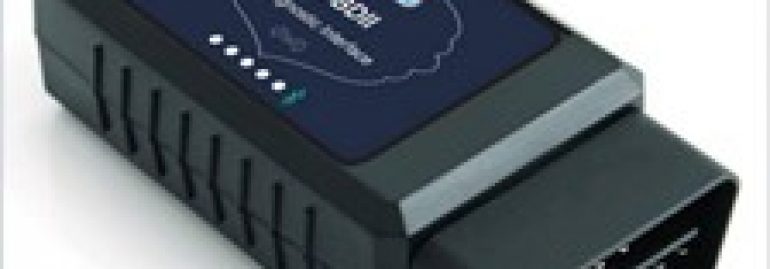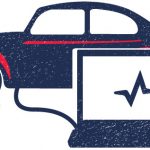Automobile Scan Tool
An automobile scan tool, also known as an OBD2 scanner, is a diagnostic device used to read and interpret data from a vehicle’s onboard computer. It allows users to identify and understand the source of various car problems, such as engine malfunctions, emissions issues, and other system failures. By providing access to real-time data and diagnostic trouble codes (DTCs), these tools empower car owners and mechanics to troubleshoot and resolve issues efficiently. An OBD-II scanner can check on a vehicle’s vital systems, providing valuable information about warning lights, airbags, ABS, and more.
How Automobile Scan Tools Work
An automobile scan tool works by connecting to the vehicle’s OBD-II port, typically located under the dashboard on the driver’s side. This port allows access to the vehicle’s onboard computer system, which constantly monitors various systems and sensors throughout the car. When an issue arises, the computer stores a corresponding DTC, which can be retrieved and interpreted using a scan tool.
To use a scan tool for most basic functions, you simply need to connect it to the OBD-II port and turn the ignition on without starting the engine. The scan tool will then communicate with the vehicle’s computer and display any stored DTCs. Depending on the type of scan tool, it may also provide additional information such as live data streams, freeze frame data, and even repair suggestions.
Safety Precautions
When connecting a scan tool to your vehicle’s OBD-II port, it’s important to take certain safety precautions to prevent potential damage to the vehicle’s electrical system. Always turn the ignition on without actually starting the engine. This is done by turning a key to the position only until the dashboard lights up, or by pressing the Start button without your foot on the brake. While you technically can start your engine while using a scanner, depending on what’s wrong with your vehicle, you risk further damaging its engine.
Types of Automobile Scan Tools
There are two main categories of OBD-II scanners: display and diagnostic.
- Display OBD-II Scanners: These scanners provide the error codes generated by your vehicle’s computer. These codes offer limited information but are a starting point for diagnosis.
- Diagnostic OBD-II Scanners: For individuals interested in DIY maintenance and repairs, diagnostic OBD-II scanners provide more detailed information on a vehicle’s internal workings, such as coolant temperature and air-fuel ratio.
Beyond these basic categories, automobile scan tools come in various forms, each with its own set of features and capabilities:
- Basic Code Readers: These are the most affordable type of scan tool, offering basic functionality such as reading and clearing DTCs. They are suitable for car owners who want to understand the cause of a check engine light and perform simple diagnostics.
- Handheld Scanners: These are more advanced than basic code readers, offering additional features such as live data streaming, freeze frame data, and the ability to perform some advanced diagnostics. They are suitable for DIY mechanics and car enthusiasts who want more in-depth information about their vehicle’s health. Examples include the Ancel BD310, which offers both corded and Bluetooth options with an excellent user interface, and the Innova 5610, which provides a wider range of diagnostic capabilities, bidirectional control, and additional diagnostic suggestions.
- Tablet Scanners: These scanners combine the functionality of a handheld scanner with the convenience of a tablet. They typically offer larger screens, more advanced features, and user-friendly interfaces. They are suitable for both professionals and experienced DIYers. An example is the GEARWRENCH GWSMART07, which offers full system diagnostics, bidirectional programming, topology mapping, and live data mapping.
- Professional Scan Tools: These are the most advanced and expensive type of scan tool, offering comprehensive diagnostic capabilities, bidirectional control, and access to manufacturer-specific data. They are typically used by professional mechanics and technicians. An example is the ICON™ T8 Professional Intelligent Diagnostic Scanner, which features advanced functionality, including IDENTIFIX® Code-Assist, compatibility with Android, and a powerful processor for lag-free operation.
As you move from basic code readers to professional scan tools, the complexity and functionality increase significantly. Basic code readers provide a simple starting point for understanding DTCs, while handheld scanners offer more in-depth data and diagnostic capabilities. Tablet scanners provide a convenient and user-friendly interface for accessing advanced features, and professional scan tools offer the most comprehensive diagnostics and access to manufacturer-specific information.
Advanced Diagnostic Features
Some automobile scan tools offer advanced diagnostic features that go beyond basic code reading and clearing. These features can be particularly useful for professional mechanics and technicians who need to perform more in-depth diagnostics and repairs. Some examples of advanced diagnostic features include:
- MOT Testing: This refers to the annual testing of vehicles for roadworthiness, ensuring they meet safety and environmental standards. Some scan tools can assist with MOT testing by providing access to relevant data and diagnostic information.
- Car Remapping: This involves modifying a vehicle’s engine control unit (ECU) to optimize performance, fuel efficiency, or other parameters. Some scan tools offer ECU coding and remapping capabilities.
- Vehicle-Specific Diagnostics: Some scan tools are designed for specific vehicle types, such as luxury cars, vans, or classic cars. These tools may offer specialized diagnostic functions and access to manufacturer-specific data.
Common Reasons for a Check Engine Light
A check engine light is one of the most common reasons car owners use an automobile scan tool. While a check engine light can indicate a variety of issues, some of the most common causes include:
- Faulty Oxygen Sensor: The oxygen sensor monitors the amount of oxygen in the exhaust gases and helps regulate the fuel-air mixture. A faulty sensor can affect fuel efficiency and emissions.
- Loose or Damaged Gas Cap: A loose or damaged gas cap can allow fuel vapors to escape, triggering the check engine light.
- Catalytic Converter Problems: The catalytic converter converts harmful pollutants in exhaust gases into less harmful substances. A malfunctioning converter can affect emissions and performance.
- Mass Airflow Sensor Malfunction: The mass airflow sensor measures the amount of air entering the engine and helps regulate the fuel-air mixture. A faulty sensor can affect performance and fuel efficiency.
- Spark Plug or Ignition Coil Issues: Worn-out spark plugs or faulty ignition coils can cause misfires and trigger the check engine light.
- Emissions System Problems: Various components in the emissions system, such as the evaporative emission control system (EVAP), can malfunction and trigger the check engine light.
Benefits of Using an Automobile Scan Tool
Using an automobile scan tool offers several benefits:
- Early Problem Detection: By identifying issues early on, you can prevent them from escalating into more serious and costly problems.
- Reduced Repair Costs: By understanding the source of the problem, you can avoid unnecessary repairs and save money on diagnostic fees. For example, a scan tool can help identify a faulty oxygen sensor or diagnose transmission problems before they lead to expensive repairs.
- Improved Vehicle Performance: By monitoring live data streams, you can identify and address performance issues, improving fuel efficiency and overall vehicle health.
- Increased Resale Value: By maintaining a detailed record of your vehicle’s health, you can increase its resale value.
- Empowerment and Knowledge: By understanding how your vehicle works and how to diagnose problems, you become a more informed and empowered car owner.
Choosing the Right Automobile Scan Tool
When choosing an automobile scan tool, consider the following factors:
- Your Budget: Scan tools range in price from under $20 to over $4,000. Determine how much you are willing to spend based on your needs and level of expertise.
- Your Needs: Consider what you want to use the scan tool for. If you only need to read and clear basic codes, a basic code reader will suffice. If you want more advanced features, consider a handheld or tablet scanner.
- Your Vehicle: Ensure the scan tool is compatible with your vehicle’s make, model, and year. Some scan tools are designed for specific vehicle types, such as cars, trucks, or motorcycles.
- Features: Consider the features that are important to you, such as live data streaming, freeze frame data, bidirectional control, and special functions.
- User Interface: Choose a scan tool with a user-friendly interface that is easy to navigate and understand.
- Updates: Ensure the scan tool offers software updates to keep it compatible with new vehicle models and technologies. Software updates are typically released periodically, often annually or as needed to address new vehicle models or technological advancements. These updates ensure that your scan tool remains compatible with the latest vehicles and provides accurate diagnostic information.
Top Automobile Scan Tool Brands
| Brand | Description | Example Products/Features |
|---|---|---|
| Innova | Popular brand known for reliable and affordable scan tools. Offers a variety of models for both DIYers and professionals. | Innova 5610 with bidirectional capabilities |
| Autel | Trusted brand offering a wide range of scan tools with advanced features and capabilities. Known for professional-grade tools and user-friendly interfaces. | Autel MaxiCOM MK808S with bidirectional capabilities and 28+ service functions |
| BlueDriver | Specializes in Bluetooth-enabled scan tools that connect to your smartphone. Offers a user-friendly app and provides detailed diagnostic information. | BlueDriver Bluetooth Pro with an intuitive app and helpful diagnostic direction |
| FOXWELL | Offers a range of scan tools with advanced features such as live data graphing and logging functionality. Known for user-friendly designs and compatibility with printers. | FOXWELL NT301 with a crisp screen and print function |
| Launch Tech USA | Offers professional-grade scan tools with comprehensive diagnostic capabilities. Known for advanced features and wide vehicle coverage. | Launch X-431 Turbo III |
| TOPDON | Offers a variety of scan tools with advanced features such as bidirectional control and key programming capabilities. Known for large displays and support for numerous advanced functions. | TOPDON Phoenix Smart Diagnostic System |
| THINKCAR | Offers a range of scan tools, including handheld and tablet models, with advanced features such as full system diagnostics and ECU coding. | THINKCAR ThinkDiag OBD2 Bluetooth Full System Diagnostic Scan Tool |
Keyword Research for Auto Repair Businesses
For auto repair businesses, understanding and utilizing relevant keywords is crucial for attracting customers and growing their business. Here are some steps to help you find the best keywords for your auto repair shop:
- Define Your Ideal Customer: Consider who your ideal customers are. Are you a specialty shop catering to luxury car owners, or do you serve a broader range of vehicles? Understanding your target audience’s demographics, preferences, and pain points is essential. Their language and needs will shape the keywords you choose.
- Brainstorm Seed Keywords: Start by brainstorming seed keywords that are central to your auto repair shop. Think about the core services you offer, such as “brake repair,” “oil change,” or “transmission service.” These seed keywords will serve as the foundation for your research.
- Utilize Specialized Keyword Research Tools: Keyword research tools can provide invaluable insights into the search habits of your potential customers. Consider using tools like Google Keyword Planner, SEMrush, Ahrefs, Serpstat, or SimilarWeb. They offer data on search volume and competition, helping you identify popular key phrases related to auto repair.
Top Websites for Automobile Scan Tool Information
| Website | Description |
|---|---|
| Car and Driver | Reviews and recommendations for OBD2 scanners |
| The Home Depot | Selection of scan tools and diagnostic testers |
| Amazon | Wide variety of scan tools with customer reviews |
Conclusion
Automobile scan tools are essential diagnostic devices that empower car owners and mechanics to understand and resolve vehicle problems efficiently. By providing access to DTCs, live data streams, and other valuable information, these tools enable early problem detection, reduce repair costs, and improve overall vehicle performance. When choosing an automobile scan tool, consider your budget, needs, vehicle compatibility, and desired features.
The market for automobile scan tools is constantly evolving, with new technologies and features emerging regularly. One notable trend is the increasing popularity of Bluetooth scanners and tablet scanners. Bluetooth scanners offer the convenience of wireless connectivity and integration with smartphones, while tablet scanners provide larger screens and more user-friendly interfaces.
Top brands like Innova, Autel, BlueDriver, and FOXWELL offer a wide range of scan tools with varying features and capabilities. Innova is known for its affordable and reliable options, while Autel provides more advanced features and professional-grade tools. BlueDriver specializes in Bluetooth connectivity and smartphone integration, and FOXWELL offers user-friendly designs with advanced data logging and graphing capabilities.
With the right scan tool, you can become a more informed and empowered car owner, ensuring your vehicle stays in top condition for years to come. Consider purchasing your next automobile scan tool from a reputable dealer. Also, remember to research the best OBD2 scanner for your specific needs.






